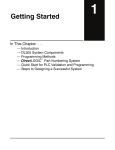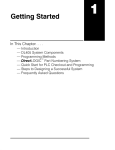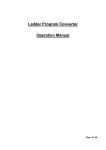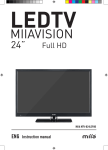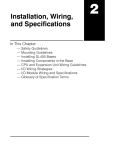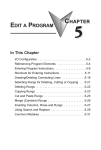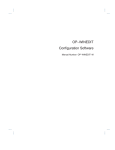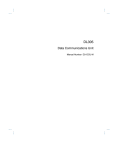Download Chapter 1 - AutomationDirect
Transcript
Getting Started In This Chapter. . . . — Introduction — DL305 System Components — DirectLOGIC™ Part Numbering System — A Few Steps to a Successful System 11 1--2 Getting Started Getting Started Introduction The Purpose of this Manual Thank you for purchasing our DL305 family of automation products. This manual shows you how to install the equipment, and it also helps you understand the system operation characteristics. Since we constantly try to improve our product line, we occasionally issue addenda that document new features and changes to the products. If an addendum is included with this manual, please read it to see which areas of the manual or product have changed. Who Should Read this Manual If you understand PLC systems our manuals will provide all the information you need to get and keep your system up and running. We will use examples and explanations to clarify our meaning and perhaps help you brush up on specific features used in the DL305 system. This manual is not intended to be a generic PLC training manual, but rather a user reference manual for the DL305 system. Where to Begin If you are in a hurry and already understand the DL305 system please read Chapter 2, Installation and Safety Guidelines, and proceed on to the chapter pertaining to your needs. Be sure to keep this manual handy for reference when you run into questions. If you are a new DL305 customer, we suggest you read this manual completely so you can understand the wide variety of products, configurations, and procedures used with the DL305 family of products. We believe you will be pleasantly surprised with how much you can accomplish with AutomationDirect products. If you’re really in a hurry, check out Appendix A. This appendix has a quick start that will show you how to quickly connect and program a very simple system. Supplemental Manuals Depending on the products you have purchased, there may be other manuals that are necessary for your application. If you have purchased analog I/O, specialty modules, or DirectSOFT, or you will be using remote I/O or networking, you will want to supplement this manual with the manuals written for these products. DL305 User Manual, Rev. D Getting Started 1--3 DL305 User Manual, Rev. D Getting Started How this Manual is Ch 1: Getting Started -- provides an overview of all the components that can be used to make up one or many DL305 systems. This chapter shows the basic Organized concepts of how the pieces fit together. It also explains the DL305 part numbering system, which will help you quickly identify the various types of modules. Ch 2: Installation and Safety Guidelines -- shows you how to prepare for system installation, and gives you guidelines for providing a safe environment for your personnel and process. Be sure to read this chapter so potential safety problems can be avoided. In this chapter you will find topics you must consider when installing a system, the environmental specifications, component dimensions, safety guidelines, installation guidelines, etc. Ch 3: DL330/DL330P/DL340 CPU Specifications -- provides details of each of the DL305 CPUs. This chapter contains the operating specifications for the CPUs, detailed information on the different types of program storage media available, and some basic procedures needed to get the CPU ready for programming. Ch 4: System Configuration, Bases and Expansion Bases -- provides selection and installation criteria for Local I/O and Local Expansion I/O. This chapter also discusses the system power budget, which is an important part of the planning and installation process. Ch 5: I/O Module Selection Criteria -- contains specific considerations which affect I/O selection such as sinking, sourcing, and temperature derating characteristics. Ch 6: Discrete Input Modules -- explains each term you will find on our specification sheets, provides specifications, wiring diagrams and derating curves (where applicable) for the DL305 Discrete Input Modules. Ch 7: Discrete Output Modules -- explains each term you will find on our specification sheets, provides specifications, wiring diagrams and derating curves (where applicable) for the DL305 Discrete Output Modules. Ch 8: System Operation -- explains how the DL305 CPUs control the system operation. This includes information on I/O updates, application program execution and memory structure. Ch 9 : RLL Programming Concepts -- explains the basic concepts used in RLL programming. Ch 10: RLL PLUS Programming Concepts -- explains the basic concepts used in the RLL PLUS programming. This programming method greatly reduces program design time and simplifies machine startup and troubleshooting. Ch 11: Instruction Set -- explains how each individual instruction operates. Ch 12: RLL PLUS Instruction Set -- explains the instructions used with the DL330P CPU. It also shows some instructions that operate differently with this CPU. Ch 13: Maintenance and Troubleshooting -- is a guide designed to aid you in diagnosing, repairing and avoiding system problems. Appendices A -- D -- there are several appendices referred to throughout the manual. These include things such as a quick start, error code listing, instruction execution times, etc. We realize even though we strive to be the best, we may have arranged our Technical information in such a way you cannot find what you are looking for. If you need Assistance assistance, please, call us at 1--800--633--0405. Our technical support group is glad to work with you in answering your questions. They are available weekdays from 8:00 a.m. to 6:00 p.m. eastern standard time. If you find a problem with any of our products, services or manuals, please fill out and return the Suggestions card included with this manual. 1--4 Getting Started Getting Started DL305 System Components The DL305 product family is one of the most versatile and widely accepted PLCs used for small control applications. These CPUs are small yet powerful. Their modular design and expansion capability blend well with todays fast moving industry. The following is a summary of the major DL305 system components. CPUs There are three CPUs in this product line, the DL330, the DL330P and the new DL340. Details of these CPU are covered in Chapter 3, DL330/DL330P/DL340 CPU Specifications. Bases Three base sizes are available in the system: 5 slot, 8 slot and 10 slot. I/O Configuration The DL330 and DL330P CPUs support up to 128 local I/O and 176 local expansion I/O. The DL340 supports 136 local I/O and 184 local expansion I/O. Each of these I/O configurations is explained in Chapter 4, Bases and Expansion Bases and I/O Configuration. I/O Modules The DL305 has one of the most diverse I/O module selections in the industry. A complete range of discrete modules which support 24 VDC, 125 VDC, 110/220 VAC and up to 10A relay outputs are offered. The analog modules provide 12 bit resolution and several selections of input and output signal ranges (including bipolar). The specialty modules include 10KHz high speed input, thermocouple, general purpose communication, and more. Programming Methods There are two programming methods available, RLL (Relay Ladder Logic) and RLL PLUS. RLL PLUS combines the added feature of flow chart programming (stages) to the standard RLL language. RLL PLUS is only available for the DL330P CPU. All of the DL305 CPUs support RLL programming. DirectSOFT supports both RLL and RLL PLUS programming. Two handheld programmers are available, the D3--HPP which supports RLL PLUS and the D3--HP which only supports RLL programming. The key pads for each handheld programmer differ, so it is recommended the handheld programmer that directly supports your CPU be used for programming. DirectSOFT Programming for Windows™ The DL305 can be programmed with one of the most advanced programming packages in the industry — DirectSOFT. DirectSOFT runs under Windows and supports many of the windows based features you are already familiar with such as cut and paste between applications, point and click editing, viewing and editing multiple application programs at the same time, browsers, etc. DirectSOFT universally supports the DirectLOGIC CPU families. This means you can use the same DirectSOFT package to program DL205, DL305, DL405 or any new CPUs we add to our product line. There is a separate manual that discusses DirectSOFT programming software. Handheld Programmer All DL305 CPUs have a built-in programming port for use with the handheld programmers (D3--HPP and D3--HP). Handheld programmers can be used to create, modify and store programs to cassette tape, as well as debug your application program. There is also a separate manual that discusses the DL305 Handheld Programmers. DL305 System Diagrams The next page shows a generic example highlighting the major components and configurations of the DL305 system. The following two pages highlight the specific components which can be used to build your system. DL305 User Manual, Rev. D 1--5 Getting Started Computer Controlled I/O Packaging Conveyors Elevators Industry Standard Computer I/O Protocol OPTOMUX™ (Serial RS422/485) PAMUX™ (Parallel) Handheld Programmer DL305 1.5ft (.05m) Getting Started Machine Control DL305 1.5ft (.05m) RS232C (max.50ft/16.2m) RS422/485 DL305 DL305 Programming or Computer Interface Computer Interface with OPTOMUX™ Driver Networking DCM Programming or Computer Interface Operator Interface DL405 Handheld Programmer RS422 RS232C (max.50ft/16.2m) DL305 RS232C/422 Convertor (max. 4.6ft / 1.5m) RS232C (max.50ft/16.2m) DL305 RS232C/422 Convertor DL305 RS232C/422 Convertor DL305 User Manual, Rev. D Getting Started 1--6 Getting Started DirectLOGIC DC INPUT 8pt 16pt 16pt 16pt 24 VDC 24 VDC 5-24 VDC 12-24 VDC DL305 Family AC INPUT AC/DC INPUT 8pt 110 VAC 16pt 110 VAC 8pt 24 VAC/DC 16pt 24 VAC/DC PROGRAMMING Handheld Programmer for RLL CPUs Handheld Programmer for RLL PLUS CPUs DirectSOFT Programming for Windows™ CPUs ASCII BASIC Modules RS232C / RS422 / RS485 Built-in Radio Modem Built-in Telephone Modem Program Memory 64K/128K DL330 3.7K RAM RLL Programming DL330P 3.7K RAM RLL PLUS Programming DL340 3.7K RAM RLL Programming and 2 Built-in RS232C Ports DL330/DL330P/DL340 EPROM Memory Chips BASES 5 Slot Base w/Expansion Capability, 110/220 VAC P/S 5 Slot Base w/Expansion Capability, 24 VDC Supply 8 Slot Base w/Expansion Capability, 110/220 VAC P/S 10 Slot Base w/Expansion Capability, 110/220 VAC P/S DL305 User Manual, Rev. D Getting Started 1--7 Getting Started DC OUTPUT RELAY OUTPUT AC OUTPUT 8pt 5--24 VDC 16pt 5--24 VDC 4 pt 8pt 16pt 16pt 8pt 8pt 8pt 16pt 110--220 VAC 110--220 VAC 12--220VAC 15--220VAC 4A/pt 5A/pt 10A/pt 2A/pt ANALOG 4ch 8ch 16ch 2ch 4ch 8ch INPUT INPUT INPUT OUTPUT OUTPUT TEMPERATURE TRANSDUCER INPUT 8ch THERMOCOUPLE INPUT SPECIALTY CPUs Bridge CPU to connect to host w/OPTOMUX™ Driver Bridge CPU w/FACTS Extended Basic Programming Bridge CPU to connect to High-speed PAMUX™ compatible host SPECIALTY MODULES / UNITS NETWORKING RS232C Data Communication Unit RS422 Data Communication Unit MODBUS® Slave Module MODBUS® Slave Module w/Radio Modem Universal connector: RS232C / RS422/485 Convertor 8pt INPUT Simulator 1pt High Speed Counter PROM Writer Unit Filler Module DL305 User Manual, Rev. D 1--8 Getting Started Getting Started DirectLOGIC Part Numbering System As you examine this manual, you’ll notice there are many different products available. Sometimes it is difficult to remember the specifications for any given product. However, If you take a few minutes to understand the numbering system, it may save you some time and confusion. The charts below show how the part numbering systems work for each product category. Part numbers for accessory items such as cables, batteries, memory cartridges etc. are typically an abbreviation of the description for the item. CPUs Specialty CPUs Product family D4-- 440DC D3-- 05B D4-- 16 N D 2 D3-- 16 N D 2 --1 D2/F2 D3/F3 D4/F4 Class of CPU / Abbreviation 230...,330...,430... Denotes a differentiation between Similar modules --1, --2, --3, --4 Bases Product family DC D2/F2 D3/F3 D4/F4 Number of slots ##B Type of Base DC or empty Discrete I/O DL205 Product family y D2/F2 / DL305 Product family y D3/F3 DL405 Product family D4/F4 Number of points 04/08/12/16/32 Input p N Output p T Combination C AC A DC D Either E Relay Current Sinking g R 1 Current Sourcing g 2 Current Sinking/Sourcing 3 High g Current H Isolation S Fast I/O Denotes a differentiation between Similar modules F --1, --2, --3, --4 DL305 User Manual, Rev. D F --1 1--9 Getting Started DirectLOGIC Part Numbering System (cont.) F3-- DL205 Product family y D2/F2 / DL305 Product family y D3/F3 DL405 Product family D4/F4 Number of channels 02/04/08/16 Input p ((Analog g to Digital) g ) AD Output p ((Digital g to Analog) g) DA Combination Isolated AND S Denotes a differentiation between Similar modules --1, --2, --3, --4 Communication and Networking, Special I/O and Devices Programming DL205 Product family D2/F2 DL305 Product family D3/F3 DL405 Product family D4/F4 Name Abbreviation see example CoProcessors and ASCII BASIC Modules DL205 Product family y D2/F2 / DL305 Product family y D3/F3 DL405 Product family D4/F4 CoProcessor CP ASCII BASIC AB 64K memoryy 64 128K memoryy 128 512K memory 512 Radio modem R Telephone modem T 04 AD S Getting Started Analog I/O --1 Altermate example of Analog I/O using abbreviations F3-- 08 THM --n note: --n indicates thermocouple type such as: J, K, T, R, S or E D4-- DCM D3-- HSC HSC (High Speed Counter) D3-- HPP HPP (RLL PLUS Handheld Programmer) F4-- CP DCM (Data Communication Module) 128 -- R DL305 User Manual, Rev. D 1--10 Getting Started Getting Started A Few Steps to a Successful System Step 1: Review the Installation Guidelines You should always make safety your first priority in any system application. Chapter 2 provides several guidelines that will help provide a safer, more reliable system. This chapter also includes wiring guidelines for the various system components. Step 2: Understand the CPU Setup Procedures The CPU is the heart of your automation system. Make sure you take the time to understand the various features and setup requirements. Step 3: Understand the I/O System Configurations It is important to understand how the I/O system can be configured. You have two different types of systems. S Local System S Local Expansion System It is also important to understand how the system Power Budget is calculated. This can affect your I/O placement and/or configuration options. Step 4: Review the I/O Selection Criteria There are many considerations involved when you select your I/O modules. Take time to understand how the various types of electrical connections can affect your choice of I/O modules. Step 5: Determine the I/O Module Specifications and Wiring Characteristics There are many different I/O modules available with the DL305 system. Chapters 6 and 7 provide the specifications and wiring diagrams for the discrete I/O modules. NOTE: Specialty modules have their own manuals and are not included in this manual DL305 User Manual, Rev. D Emergency Stop 030 020 010 000 to to to to 037 027 017 007 130 120 to to 137 127 110 100 to to 117 107 C P U 060 050 040 to to to 067 057 047 160 150 140 to to to 167 157 147 DL305 DL305 1--11 Getting Started Step 7: Review the Programming Concepts Step 8: Choose the Instructions Before you begin to enter a program, it is very helpful to understand how the DL305 system processes information. This involves not only program execution steps, but also involves the various modes of operation and memory layout characteristics. All control systems differ in some areas. The DL305 CPUs offer two different types of programming. RLL programming available for all the DL305 CPUs, uses conventional ladder diagram type solutions for many application problems. RLL PLUS is available for the DL330P CPU. This method of programming greatly reduces the program design time and makes program troubleshooting and machine startup considerably easier. Once you have installed the system and understand the theory of operation, you can choose from a diverse instruction set to implement your application. Power up Getting Started Step 6: Understand the System Operation Initial Mode Setting Initialize memory RLL Programming output 010 input 000 RLL PLUS (flowchart) Programming ISG S0 SG S1 J TMR T1 K 30 CNT CT3 K10 Step 9: Understand the Maintenance and Troubleshooting Procedures Many things can happen on the factory floor. Switches fail, batteries need to be replaced, etc. In most cases, the majority of the troubleshooting and maintenance time is spent trying to locate the problem. Chapter 13 provides some information that will help you quickly identify problems, so you can look like a hero if you take time to understand them. DL305 User Manual, Rev. D












